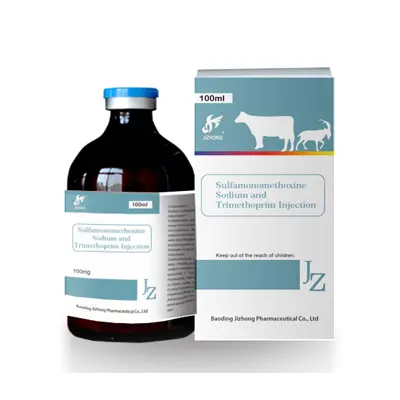What Is Livestock Compound Sulfamethoxydiazine Injection
March 09,2022
Livestock Compound Sulfamethoxydiazine Injection is a colorless to slightly yellow clear liquid with the property of being easily deteriorated when exposed to light. In the previous blog, we mainly introduced its pharmacological effects, and learned that it is a broad-spectrum bacteriostatic agent, which has an inhibitory effect on very bacteria. So, in this blog, let's take a look at its antibacterial mechanism.
What is the antibacterial mechanism of compound sulfadiazine injection?
The antibacterial mechanism of sulfadiazine is to inhibit the growth and reproduction of bacteria by inhibiting the synthesis of folic acid. In the process of growth and reproduction of bacteria sensitive to this drug, exogenous folic acid cannot be directly used from the growth environment, but para-aminobenzoic acid (PABA) in vitro must be used. Hydropteridine is used to synthesize dihydrofolate, and then tetrahydrofolate is formed by the action of dihydrofolate reductase, which is further combined with purine, pyrimidine and other substances to synthesize nucleic acid.

Sulfadiazine has a similar chemical structure to PABA, and can compete with PABA for dihydrofolate synthase, thereby hindering the synthesis of folic acid in sensitive bacteria and exerting a bacteriostatic effect. Higher animals can directly utilize exogenous folic acid, so its metabolism is not disturbed by sulfonamides.
During the use of sulfadiazine, due to insufficient dose and course of treatment, bacteria are prone to develop drug resistance, especially Staphylococcus, followed by Escherichia coli and Streptococcus. After bacteria develop resistance to sulfadiazine, they can also develop different degrees of cross-resistance to other sulfa drugs, but there is no cross-resistance with other antibacterial drugs.
Sulfadiazine is easily absorbed when taken orally, and its bioavailability varies with different animal species. The general order is: poultry>dog>pig>horse>sheep>cattle. After the drug is absorbed, it can be distributed in the whole body tissues and body fluids of animals, with higher content in blood, liver and kidney, and lower content in nerve, muscle and fat.
The apparent volume of distribution of sulfadiazine in dogs is 1.02 L/kg. The solubility of this product in blood is higher than that of other body fluids, the blood concentration is easy to reach an effective level, and the binding rate of the drug to plasma proteins is low (24% for cattle, 17% for dogs, and 16% for poultry), and it is easy to pass through the blood-brain barrier. It is easy to enter the cerebrospinal fluid, and can reach a higher drug concentration (up to 50% to 80% of the blood concentration).
Sulfadiazine is mainly metabolized in the liver, and the most common way of metabolism is acetylation of the para-amino group. Different species of animals have different degrees of acetylation, and the order is: cattle>rabbit>sheep>horse, cat>dog>avian. After the drug is acetylated, it loses its antibacterial activity, but maintains its original toxicity. The longer the free sulfadiazine is maintained in the body, the higher the acetylation rate. The second metabolic mode is hydroxylation, which can also be combined with glucuronide. Oxidation in ruminants is an important pathway for its metabolism. For example, sulfadiazine is oxidized to 2-sulfonamide-4-hydroxypyrimidine in goats and loses its activity.
The half-life of sulfadiazine in different animals varies greatly, it is 9.84 hours in dogs, 5.41 hours in horses, 2.57 hours in cattle, 2.35 hours in buffalo, 5.53 hours in chickens, 5.55 hours in sheep, 1.82 hours in dairy goats, and 1.82 hours in pigs. 2.38 hours.
Sulfadiazine is mainly excreted by the kidneys in the form of the original form, acetylated compounds and glucuronide conjugates. When renal function is impaired, the half-life of the drug is prolonged. A small amount of sulfadiazine is also excreted in breast milk, digestive juices and other secretions.
What diseases does livestock Compound Sulfamethoxydiazine Injection treat?
It is mainly used to treat digestive tract and respiratory tract infections, mastitis, endometritis and other diseases caused by sensitive bacteria in livestock, such as diarrhea caused by Escherichia coli and Salmonella, swine pneumonia caused by Pasteurella multocida and Streptococcus suis, etc., can also be used for Toxoplasma gondii infection.
What are the adverse reactions of Compound Sulfadiazine Injection?
Last few words
The above is the role of compound sulfadiazine injection, and its adverse reactions. After taking it, you should always pay attention to the reaction of livestock. We are a Compound Sulfadiazine Injection supplier, if you want to bulk Compound Sulfadiazine Injection, please feel free to contact us!